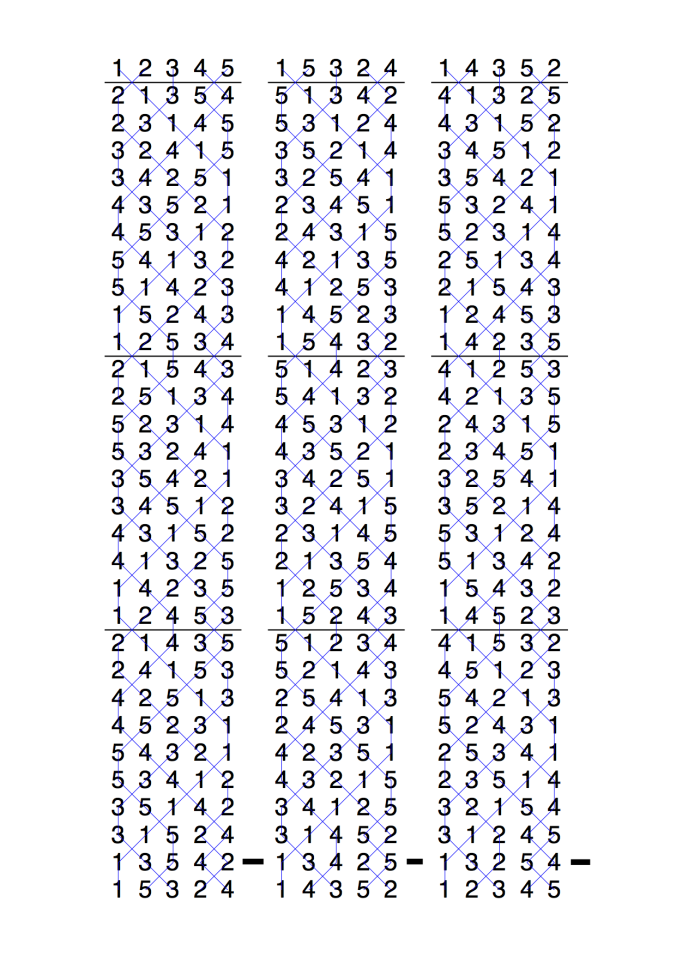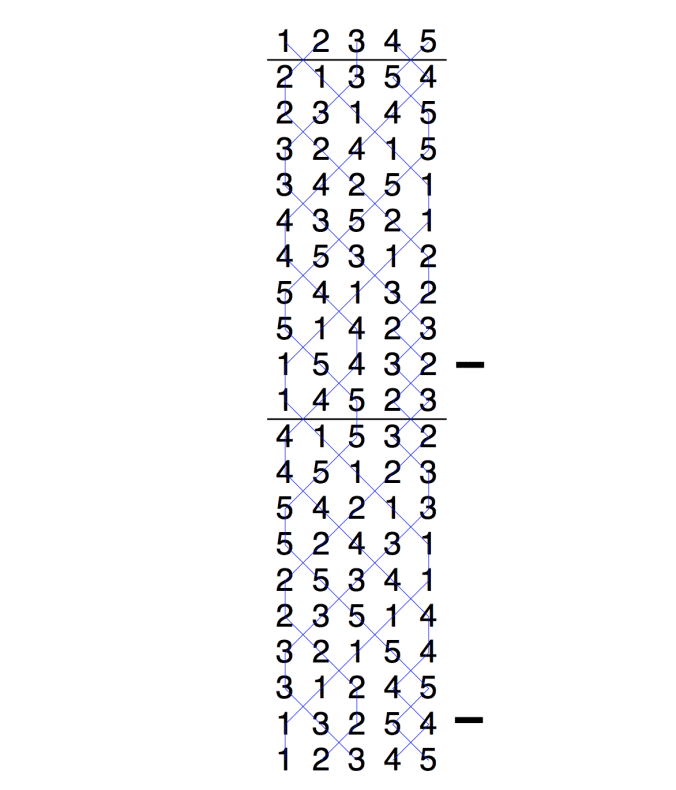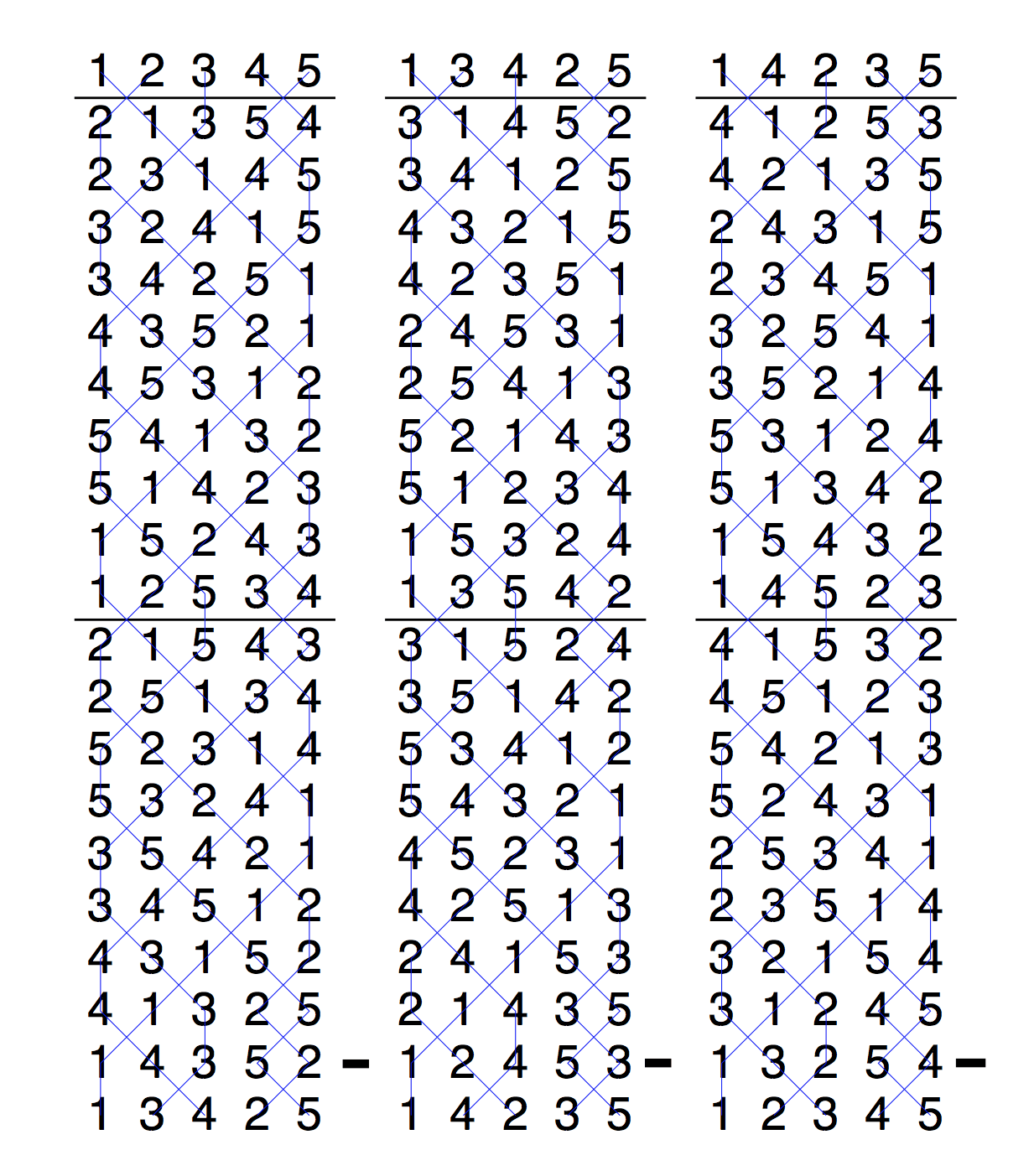14: Bobs in Grandsire Doubles.
It’s time to set about getting more rows from Grandsire Doubles. This next bit’s pretty technical, but stick with it!
We need to introduce a new idea, something which stops the bells running round after only 30 rows. This new idea is called a bob.
Remember how Grandsire has a bell making 3rds just after the treble leads. At a bob in Grandsire, a bell also makes 3rds just before the treble leads.
Let’s call a bob at the end of the third lead of the plain course, just before the bells would run round. That brings up the row 15324. You can see it on the diagram below, at the bottom of the first column. A bob is shown by a dash to the right of the rows.

Notice how, at the bob, the 5th makes 3rds just before the treble leads. Notice also that the 5th takes over the role that the 2nd had in the plain course (to plain hunt all the time). The 5th becomes the new hunt bell until the next bob, and the 2nd takes over from it as a working bell.
We can now ring another plain course, but starting from the row 15324. We’ll need another bob three leads later, otherwise we’ll be back to 15324. The bob at the end of the sixth lead (the bottom of the second column) brings up 14352. The 4th goes into the hunt. Three more leads with a bob at the end brings us back to rounds.
Using ‘p’ to represent a normal, plain lead and ‘-‘ to represent a bobbed lead, we have the following touch of 90 rows:
pp-pp-pp-
There’s only one thing wrong with this touch: it’s false. See if you can see where the repeated rows occur.
Ok. What if we tried having only bobbed leads?
Now we get a true touch. Unfortunately, at just 20 rows (two leads) long, it’s even shorter than the plain course. Here it is:

Let’s try alternate plain and bobbed leads, like this:
p-p-p-
Yes! That works, and gives us 60 true changes. Here they are:

This touch, like most touches, is a ‘round block‘. Like a circle, its beginning joins up with its end. Once you get to the end, you could just carry on and do it all again if you wanted to.
A useful thing about a true round block is this:
- you can start and end at any row and it will still be true.
Now we probably don’t want to start in the middle of a lead, but we could start our 60 of Grandsire with a bobbed lead instead of a plain lead and ring this:
-p-p-p
You might like to write it out and check that it has 60 true changes. Now here’s a question:
- Are they the same 60 changes as we got from the other version of this touch? (You’ll remember that the first version started with a plain lead: p-p-p- )
A related question is this (though it probably isn’t obvious how it’s related):
- How do I know, without bothering to write it out, that any touch of 90 Grandsire Doubles which uses only plain leads and bobbed leads (like the one above) mustbe false?
I’ll be impressed if you can answer that question!
I haven’t forgotten that I haven’t yet talked about how to ring Grandsire Doubles on an inside bell. That’ll come soon. In the meantime, keep doing lots of trebling, and start to look at what the other bells are doing around you. When you’re trebling to Grandsire:
- Can you see the bell(s) making 3rds at the lead end?
- Can you see, or hear, which bell is leading when you’re at the back of the change?
- As you hunt down, can you see which bell is hunting down immediately in front of you (your course bell)?
- After a bob or a single, can you see which is the new hunt bell?
- I haven’t talked about singles yet. Can you see what happens at a single?
- Can you see or hear which bell has gone wrong if there’s a mistake?
- Can you keep the treble in the right place even if there’s a fire out going on? A good steady treble ringer who stays calm under fire is a real asset to any band.



